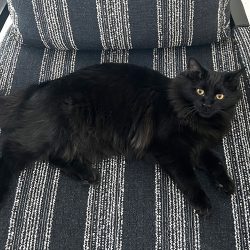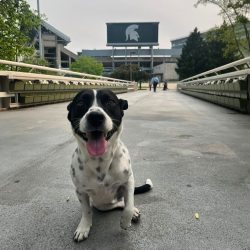History and Diagnosis
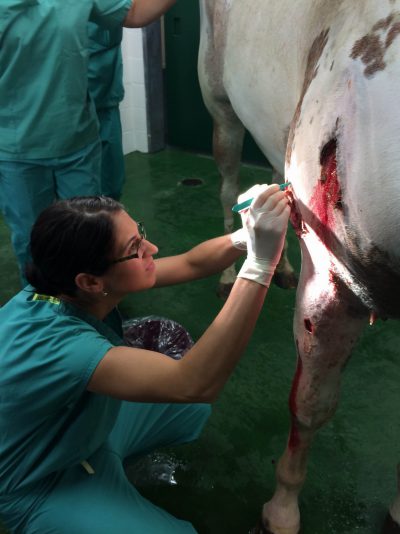
Chrome, a six-year-old Paint gelding, presented to the MSU Veterinary Medical Center Equine Emergency Service for evaluation of a non-healing wound on his right shoulder. Two weeks prior to his presentation, Chrome was injured by a stall latch, causing a fullthickness laceration on his right shoulder. The wound was closed on the farm and Chrome was administered antibiotics and pain medication. At the time of the injury, Chrome was unable to advance his right forelimb, but was able to bear weight on it.
While on stall rest, Chrome’s owner noticed that the wound was not healing. Multiple other areas along the shoulder, ventral chest, and lower limb opened and were now draining a foul-smelling discharge. Chrome’s lameness had not improved and he was referred to MSU for further diagnostics and treatment.
On Chrome’s initial physical examination, he was able to bear weight on the right forelimb, but required assistance advancing the leg forward while walking into the Hospital. Multiple open and draining wounds were present on the right forelimb and pectoral region. The right forelimb was swollen to approximately twice its normal size, hot, and sensitive to physical contact. Chrome’s heart rate was elevated and a temperature was also noted on examination.
Routine blood work was normal and radiographs were taken of the right shoulder and elbow. These radiographs revealed severe soft tissue swelling with gas present in the tissues. The bony structures of the elbow and shoulder were unaffected. An ultrasound of the region was limited due to the extensive gas within the tissue that extended through draining tracts to the level of the carpus. Cultures were submitted to identify the bacteria causing the infection. Following two days of incubation, the results revealed several species, including Clostridium perfringens, Pseudomonas aeruginosa, and Streptococcus sp.
Treatment and Outcome
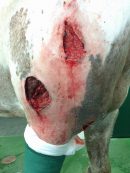
Chrome was treated at the Veterinary Medical Center by Drs. Vanessa Cook and Tara Shearer. Drs. Frank Nickels and Marc Kinsley aided in Chrome’s daily care and hospitalization.
On presentation, clinicians administered broad spectrum intravenous antibiotics to treat the extensive infection within his skin and muscles, which involved a large part of his triceps muscle and tracked in several directions. This necessitated daily wound debridement and removal of large portions of Chrome’s infected muscle. An incision was made distally on the limb at the ventral-most aspect of the migrating infection. This incision allowed for drainage of the trapped purulent material and also prevented further spread of the infection.
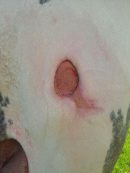
Meticulous wound care was performed twice daily and Chrome’s lower leg was wrapped to minimize the swelling. He was closely monitored in his stall, as he was unable to rise on his own due to limited range of motion and pain within the right leg.
A team of dedicated staff was needed to assist him to stand after laying down. Chrome was treated at the Veterinary Medical Center for nearly a month. Over that time, the infection resolved and the wounds began to fill with healthy granulation tissue. Chrome’s level of comfort increased and his ability to advance his limb, while still limited, improved greatly.
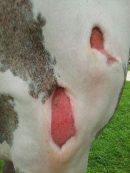
Chrome was switched to an oral antibiotic and returned home. His owners were dedicated and diligent in maintaining his wound care and performing passive range of motion exercises to increase the flexibility in the right leg. Weekly updates and pictures were provided to the clinicians on his case and we were able to monitor Chrome’s progress. His multiple wounds healed very well, aside from one wound on the shoulder region. This wound was not healing as quickly as the others due to the increased amount of motion in this area.
Chrome returned to MSU for debridement of the wound and a stent bandage to decrease the tension around the wound. Since that last visit, Chrome has been doing very well at home and is on his way to full recovery.
Comments
Any wound on a horse can be life-threatening, depending on the location, the structures involved, and how extensive it is. Additionally, secondary infections can lead to severe and debilitating injuries.
In Chrome’s case, the deep infection and extensive nature of that infection made this wound very difficult to treat at home. The MSU Veterinary Medical Center has board certified specialist veterinarians, veterinary students, and licensed veterinary technicians that are available 24 hours a day for the intensive nursing care that Chrome required.


